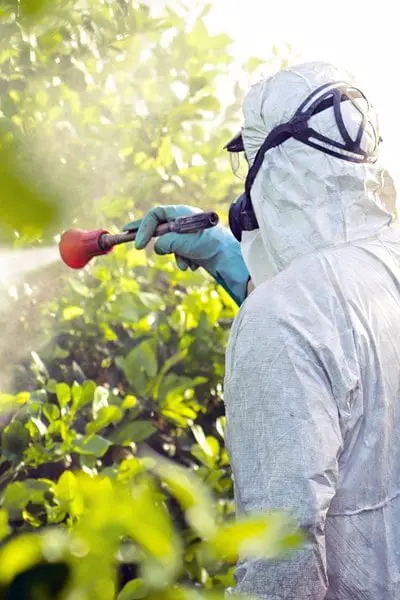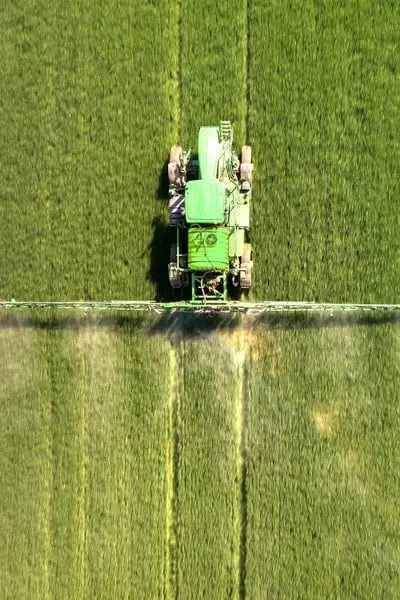Pesticide drift is the movement of pesticides through the air from an area where they were applied to any unintended site.
This can be harmful to soil, nature, animals, and humans since pesticides are dangerous chemicals.
So, this might make you wonder: What is a safe distance from pesticide drift? Can living near an area where pesticides are used be dangerous?
What Is A Safe Distance From Pesticide Drift?
It’s recommended not to have any residential areas near a pesticide drift except for a farm. The safest distance to stick to is at least three kilometers, but it might be less or more, depending on how much pesticide was used.
Pesticide drift can travel quite far away, but the actual distance depends on the speed of the wind and the size and concentration of the particles. Experts recommend staying indoors for about 30 minutes after spraying pesticides on the farm.
Further, if you leave nearby a place that’s known for pesticide drift, make sure to stay inside when it’s being sprayed as well. So, it’s also important to use common sense when trying to figure out a safe distance.
What are the dangers of pesticide drift?

Pesticides are substances commonly used to destroy insects and other organisms harmful to cultivated plants and animals. But while they’re essential in agriculture, they’re actually quite strong chemicals.
So, it’s not surprising that pesticide drift has negative effects on human health.
The effects of pesticides on human health depend on the level of inhalation and how long the person has been exposed to the chemicals.
The most common symptoms include eye irritation, nose irritation, runny nose, coughing, wheezing, and rash. These signs usually appear quickly after exposure, which is why it’s important to stay inside after spraying pesticides on a farm.
People living further away from a farm are less likely to experience these symptoms. This is because pesticide drift isn’t as dense as freshly sprayed pesticides. But they can still occur.

Other dangers of living close to pesticide drift result from prolonged exposure.
These include birth defects, cancer, reproductive problems, immunotoxicity, neurological and developmental issues, and disruption of the endocrine system.
Aside from direct effects on human health, pesticides can also harm animals if they’re not kept away from these chemicals. So, it’s important to move any animals away from the areas where pesticides are used.
On top of that, the use of pesticides has long been studied for its negative effects on the environment. They work as pollutants, worsening quality, particularly if they’re sprayed in large quantities.
Additionally, pesticide drift can harm aquatic life when it travels into the water through crop run-off. This can poison animals or even threaten their extinction.
There are many laws in place that try to prevent pesticide usage near large bodies of water, but pesticide drift can still travel there.
Finally, pesticides that have traveled further away from the place of application can also negatively impact the soil. Pesticides can cause a nutrient loss in the soil, affecting plants, various microorganisms, and animals.
The negative effects of pesticides also depend on the type of substances used. So, they might be more or less severe.
How far can a chemical pesticide travel?

Pesticide drift can travel long distances, depending on the strength and direction of the win and the size and density of the particles.
Larger, heavier particles don’t tend to travel far away, but smaller ones might go as far as three kilometers or even further, depending on the speed of the wind.
Because of that, it’s important to stay indoors right after using pesticides to avoid inhaling the particles.
It’s also important to consider how long the particle stay suspended in the air before they evaporate. If they’re small, they might remain in the air for a long time, drifting even further away than three kilometers.
That’s why it can often be hard to determine how far pesticides travel in a specific area.
Additionally, just like with the negative health effects, the distance pesticides can travel depends on the type of substance used. Some of them are heavier than others, making them less likely to drift far away.
Should you live close to a pesticide drift?

Since pesticides can remain suspended in the air for some time, traveling to unwanted areas, it’s generally not recommended to live near a known pesticide drift.
In general, many environmental and governmental organizations keep a close eye on any construction of residential buildings near pesticide drifts.
But, unfortunately, it’s often hard to prevent, seeing as pesticide drift can travel far and in different directions.
On the bright side, though, you can make a conscious effort to check whether there is pesticide drift in the location where you’re looking to buy a house. So, there are many ways to stay safe.

Of course, farmers and others who work on a farm have no choice but to live in an area where pesticides are regularly used.
In this case, it’s important to stay inside for at least 30 minutes after spraying pesticides on the crops. That way, you can avoid inhaling these toxic chemicals and risking serious health issues.
It’s also crucial to moving any farm animals away from the area where pesticides are being used.
This is because pesticides are harmful not only to humans but also to animals. Plus, animals might spread the pesticides to other areas on the farm.
So, be sure to keep these things in mind.
Conclusion
There are many factors that need to be taken into consideration when determining the safe distance from pesticide drift.
But to stay in the safe zone, make sure to stay inside after spraying pesticides and avoid living in residential areas located close to pesticide drifts.
That way, you can avoid serious health issues, including poisoning.
In general, it’s hard to prevent pesticide drift from occurring. But luckily, there are many steps you can take to reduce its impact on your health and the environment.
Sources: PMC, Minnesota Poison Control System, Science Direct, and Ohio State University

Jack is the owner, chief editor, and senior writer of this website.
Machinery, engines, and farming have always been a passion of his since he was a young boy. Growing up on a small farm in rural America, he learned the value of hard work and dedication from an early age.
After completing his degree in Engineering, he decided to follow his dream and became a farmer in 2009.
Since then, he has gained a wealth of knowledge and experience in the field. He has grown a variety of crops, tended to farm animals, and worked with all sorts of farming machinery. Continue reading…





